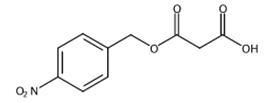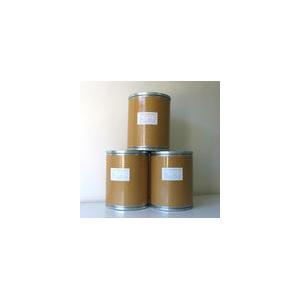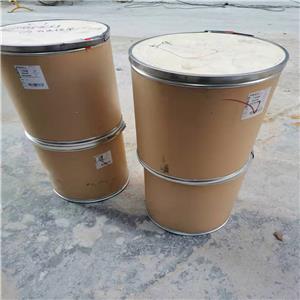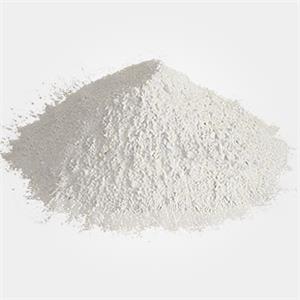丙二酸单对硝基苄酯的合成及其应用
发布日期:2022/11/30 15:00:50
简介
乙酸苄酯是性能优良的天然等同香料和工业用溶剂[1]。随着经济的发展和我国人民生活水平的提高,在食品加工、日用化工、油漆、纺织等相关行业中,对乙酸苄酯的需求量将会增加。使企业获得良好经济效益和社会效益的关键在于优化生产工艺,考察上述合成乙酸苄酯所采用的催化剂及合成工艺,均能克服硫酸催化的某些弊端。选择催化剂应从价廉易得,制备方便,便于回收使用,设备投入少,后处理工艺简单,带水剂的毒性低,废液排放量少诸方面考虑[2]。相比较而言,固体超强酸是催化合成乙酸苄酯的高效、经济、环境友好的酯化催化剂,具有工业化应用前景。

图1丙二酸单对硝基苄酯的结构式。
合成

图2丙二酸单对硝基苄酯的合成路线[3]。
将丙二酸二对硝基苄基(100g)和甲苯(750ml)装入置于水浴中的烧瓶中。水浴温度升至55°C。丙二酸二对硝基苄基酯溶解后,向反应混合物中加入250ml磷酸钾缓冲液(0.1M,pH 7.5),并保持pH 7.5。将水浴温度降至45°C,并将固定化的CalB(Candida antarctica脂肪酶-C-LEcta,德国;5g)添加到反应混合物中。将1N氢氧化钠滴加到反应混合物中,以保持和控制pH在7.5。将反应混合物搅拌7小时。过滤反应混合物以回收酶,并在五氧化二磷存在下在干燥器中真空干燥过夜。从反应混合物中回收酶后,分离甲苯和水层,在真空下浓缩甲苯层,得到对硝基苄醇(38g)。在0°C至5°C下用6N盐酸将水层的pH调节至2.0,以促进丙二酸单对硝基苄基酯的结晶。过滤结晶的丙二酸单对硝基苄酯,并在50℃下真空干燥。产量:58 g纯度(通过HPLC):99.83%,水分含量:0.14%。合成路线如图2所示。

图3丙二酸单对硝基苄酯的合成路线[4]。
在氩气下,将Meldrum酸(5.00g,34.7mmol)和无水MeCN(40mL)加入火焰干燥的150mL压力管中。向所得溶液中加入对硝基苄醇(5.58克,36.4毫摩尔)。盖紧管子。使反应回流过夜。在减压下浓缩反应。用柱色谱(55/45己烷/EtOAc)纯化残余物,得到丙二酸单对硝基苄酯。产率为87%。合成路线如图3所示。
应用
丙二酸单对硝基苄酯是造漆、纺织和染料等行业的优良溶剂,用作虫胶漆、醇酸树脂、硝酸纤维素、醋酸纤维素、染料、油脂、印刷油墨等的溶剂[5-6]。因其具有良好的溶剂性能且低毒,在兽药及饲料行业用于药品的喷洒溶剂。在化学溶剂使用方面,丙二酸单对硝基苄酯常作为虫胶漆、醇酸树脂、硝酸纤维素、醋酸纤维素、染料、油脂和印刷油墨等溶剂[7]。
丙二酸单对硝基苄酯还是我国规定允许使用的食用香料。主要用以配制茉莉、桃子、杏子、树莓、草莓、苹果、葡萄、香蕉、樱桃、梨、菠萝、木瓜、奶油等型香精。FEMA(美国食用香料制造者协会)允许将其用于软饮料、冷饮、糖果、焙烤食品、布丁类及胶姆糖。丙二酸单对硝基苄酯对花香和幻想型香精具有提香作用,广泛而大量地用于日化香精和食品香精中,是目前合成香料工业产量的品种之一[8-9]。在400种著名的加香产品中,如香水、化妆品香精、香皂香精,其用量排名均在前5名之内,是日化香精中使用量最多的酯类香料。在香料行业中丙二酸单对硝基苄酯常用于配制苹果、生梨、香蕉、樱桃、李子、菠萝等香型的食用香精[10]。丙二酸单对硝基苄酯在日化行业中用作肥皂加香剂。此外,在纺织和染料行业,丙二酸单对硝基苄酯的用途也很广泛[11]。随着国内食品加工业的发展和人们对食品的色香味方面的更高要求,预计丙二酸单对硝基苄酯的需求量也将呈逐年上升的趋势,市场前景看好。
参考文献
[1] R.G. da Rocha, E.M.S. Santos, A.M. Tanaka-Azevedo, C. Serino-Silva, M.G.d. Souza, E.S.B. Gomes, F.A.D. Guimaraes, L.H. Silveira, S.H.S. Santos, A.M.B. de Paula, R.S. Gomez, A.L.S. Guimaraes, L.C. Farias, The antineoplastic potential of crotoxin isolated from Crotalus durissus terrificus snake venom on oral squamous cell carcinoma, Toxicon (2022) Ahead of Print.
[2] L.N. Kotter, L.J. Groven, Nitrocellulose-Based Green-Light Illuminants: A Study of Barium Nitrate Particle Size on Spectral Performance, Propellants, Explos., Pyrotech. (2022) Ahead of Print.
[3] B. Liang, H. Bai, B. Tan, D. Bai, Sources apportionment of water-soluble inorganic salts in CPM from coal-fired power plants with different emission control technologies, Fuel (2022) Ahead of Print.
[4] S. Ma, X. Li, H. Zhao, K. Ma, A kind of high strength composite corrugated paper board [Machine Translation], Yunnan Lingdong Printing and Packaging Co., Ltd., Peop. Rep. China . 2022, p. 8pp.
[5] J.L. Neira, B. Rizzuti, S. Araujo-Abad, O. Abian, M.E. Farez-Vidal, A. Velazquez-Campoy, C. de Juan Romero, The armadillo-repeat domain of Plakophilin 1 binds to human enzyme PADI4, Biochim. Biophys. Acta, Proteins Proteomics (2022) Ahead of Print.
[6] A. Sen, D. Ozbeyli, K. Terali, F. Goger, A. Yildirim, B. Ertas, A. Dogan, L. Bitis, G. Sener, Protective effects of Rubus tereticaulis leaves ethanol extract on rats with ulcerative colitis and bio-guided isolation of its active compounds: A combined in silico, in vitro and in vivo study, Chem.-Biol. Interact. (2022) Ahead of Print.
[7] D. Shi, Y. Ni, G. Li, Z. Yan, Q. Zhao, W. Xie, X. Meng, J. Chen, A computational study of Mg m H n nanoclusters with n:m ≥ 2:1 for efficient hydrogen storage, Int. J. Quantum Chem. (2022) Ahead of Print.
[8] O. Suefer, Z.D. Celik, F. Bozok, Influences of Some Aromatic Plants on Volatile Compounds and Bioactivity of Cultivated Pleurotus citrinopileatus and Pleurotus djamor, Chem. Biodiversity (2022) Ahead of Print.
[9] J. Sun, M. Wu, L. Wang, P. Wang, T. Xiao, S. Wang, Q. Liu, miRNA-21, which disrupts metabolic reprogramming to facilitate CD4+ T cell polarization toward the Th2 phenotype, accelerates arsenite-induced hepatic fibrosis, Ecotoxicol. Environ. Saf. (2022) Ahead of Print.
[10] H. Yao, J. Yao, With non-slip crease resistance of sheet [Machine Translation], Nantong Jieyuan Textile Co., Ltd., Peop. Rep. China . 2022, p. 8pp.
[11] M. Zhu, L. He, J. Liu, Y. Long, J. Shentu, L. Lu, D. Shen, Dynamic processes in conjunction with microbial response to unveil the attenuation mechanisms of tris (2-chloroethyl) phosphate (TCEP) in non-sanitary landfill soils, Environ. Pollut. (Oxford, U. K.) (2022) Ahead of Print.
欢迎您浏览更多关于丙二酸单对硝基苄酯的相关新闻资讯信息



